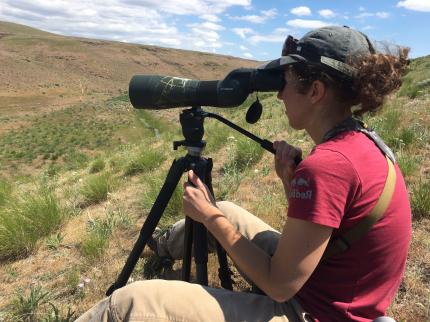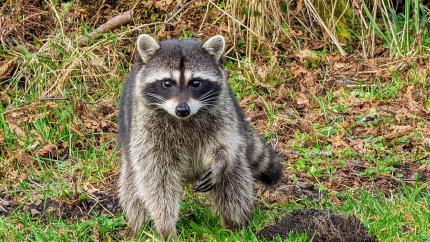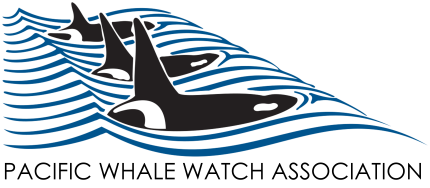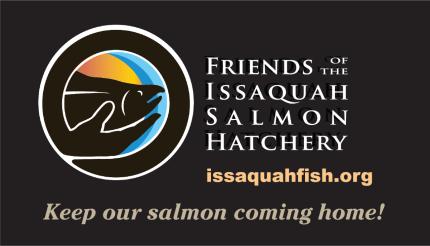Wildlife can be found anywhere. From backyard chickadees to the orcas of the Salish Sea, there is a spectacular array of wildlife to witness.
Whether you are outside on a wildlife area or water access area or inside on your couch looking at live fish and wildlife web cameras, there are a variety of ways you can experience wildlife!
Plan your adventure
Wildlife watching can be as simple or as in-depth as you would like to make it. It is helpful to know where to go, what you're seeing, how to be prepared and respectful of wildlife and others, and how to share your wildlife sightings.
Wildlife viewing locations

We manage more than 1 million acres of public land where you can experience wildlife and explore with friends, family, or on your own. Find a wildlife area or water access area near you, or just explore your local neighborhood, park, beach, or yard.
Wildlife can be found anywhere!
Additional places to explore
Wildlife in Washington
There are thousands of animal species in Washington, including mammals, birds, amphibians and reptiles, fish, and invertebrates. Check out more about these species and their habitats.
Be prepared
Before going outdoors, know where you are heading and bring essentials.
Pack the following:
- Clothing and items that will suit all weather conditions, such as sunscreen, a jacket or two, and appropriate footwear.
- Always have plenty of water and snacks.
- When looking for wildlife, it’s helpful to have a pair of binoculars, a spotting scope, a camera with a zoom lens, and/or ID guides, although they are not required.
Respect local guidelines and restrictions when it comes to land, trail, and park closures.
Don’t forget parking! Visitors to WDFW-managed lands and water access areas must have either a Discover Pass or Vehicle Access Pass to park. You may also be able to borrow a Discover Pass from your local library.
Be respectful
People appreciate wildlife in many ways, from hunting and tracking to birding and photography. Be mindful of how your actions may impact others, including wildlife, while enjoying your time outside.
Give wildlife plenty of space and be inclusive of others when enjoying the outdoors. Learn more about wildlife viewing ethics.
Contribute to science
Photos and videos of wildlife can inspire others to get outside and enjoy being in nature. Not to mention, we love to know what you encounter! Share your experience with us and share your photos.
You can also share your wildlife observations on community science platforms such as eBird, iNaturalist, or our own Report Wildlife Observations webpage.
Connect with wildlife wherever you are
You can experience wildlife from your home, school, or business using the resources below.
Support the Watchable Wildlife program

The Watchable Wildlife Program as defined by RCW 77.32.560 includes but is not limited to:
- Initiating partnerships with communities to jointly develop watchable wildlife projects
- Building infrastructure to serve wildlife viewers
- Assisting and training communities in conducting wildlife watching events
- Developing destination wildlife viewing corridors and trails, tours, maps, brochures, and travel aides
- Offering grants to assist rural communities in identifying key wildlife attractions and ways to protect and promote them.
Wildlife viewing activities benefit each time a Washington resident buys a bald eagle license plate. Purchase yours today!
Watchable Wildlife grant
The Watchable Wildlife Grant supports wildlife viewing opportunities and fosters stewardship of wildlife in Washington. It is open for applications every odd year.
We prioritize initiatives that are brought forward by or are co-developed with underserved and marginalized communities to address stated community needs that are imbued with equity and justice values.
Tips and tricks
It is recommended that you review the following guidelines to have a safe, rewarding, and responsible wildlife-viewing experience.
- Wildlife Viewing Tips and Tricks from WDFW
- Tips for sharing WDFW managed lands during hunting seasons
- Birding ethics from the American Birding Association
- Bird photography and videography tips and ethics from the Audubon Society
- Wildlife photography tips and ethics from the Washington Trails Association and National Geographic
- Orca whale watching from WDFW
Blogs
Here are some of the most recent blog posts. Find more wildlife viewing blogs in the WDFW Newsroom.
Wildlife in distress
Orphaned or injured wildlife
If you see an animal that could be orphaned or injured, learn what to do next. In the event of an immediate public safety issue, wildlife violation, or dangerous animal, please call 911. For non-emergency issues, please contact the WDFW Enforcement office at 360-902-2936 or email enforcement-web@dfw.wa.gov.
Marine wildlife in distress
Marine mammals are protected under the Marine Mammal Protection Act. To report a dead, injured, or stranded marine mammal, please call the National Oceanic and Atmospheric Administration (NOAA) West Coast Region Stranding Network hotline at 866-767-6114.

Nuisance wildlife
WDFW offers guidance and information on how to deal with problematic animals on and around your property. Search the resources available to help with nuisance wildlife.















